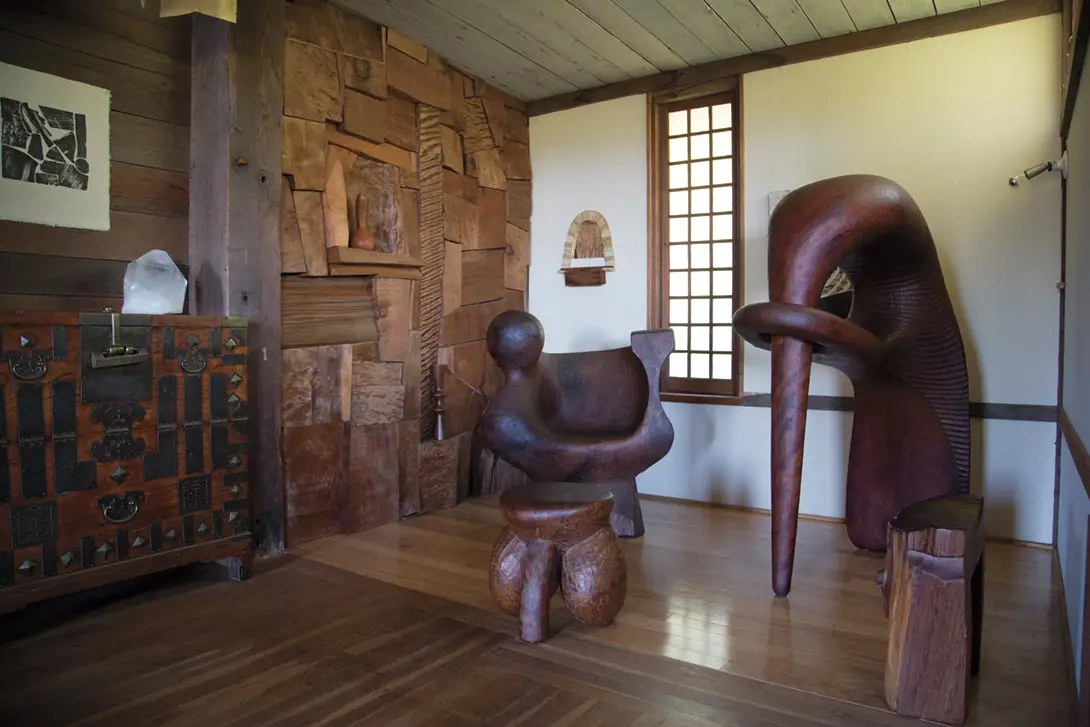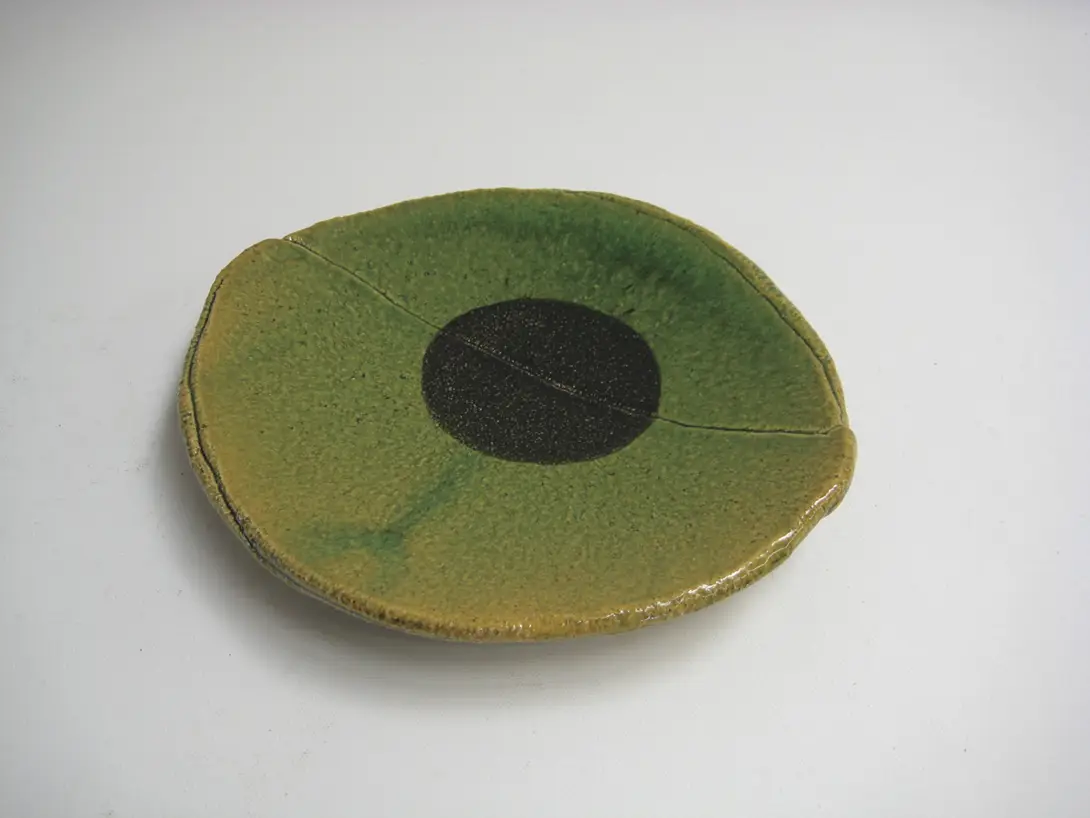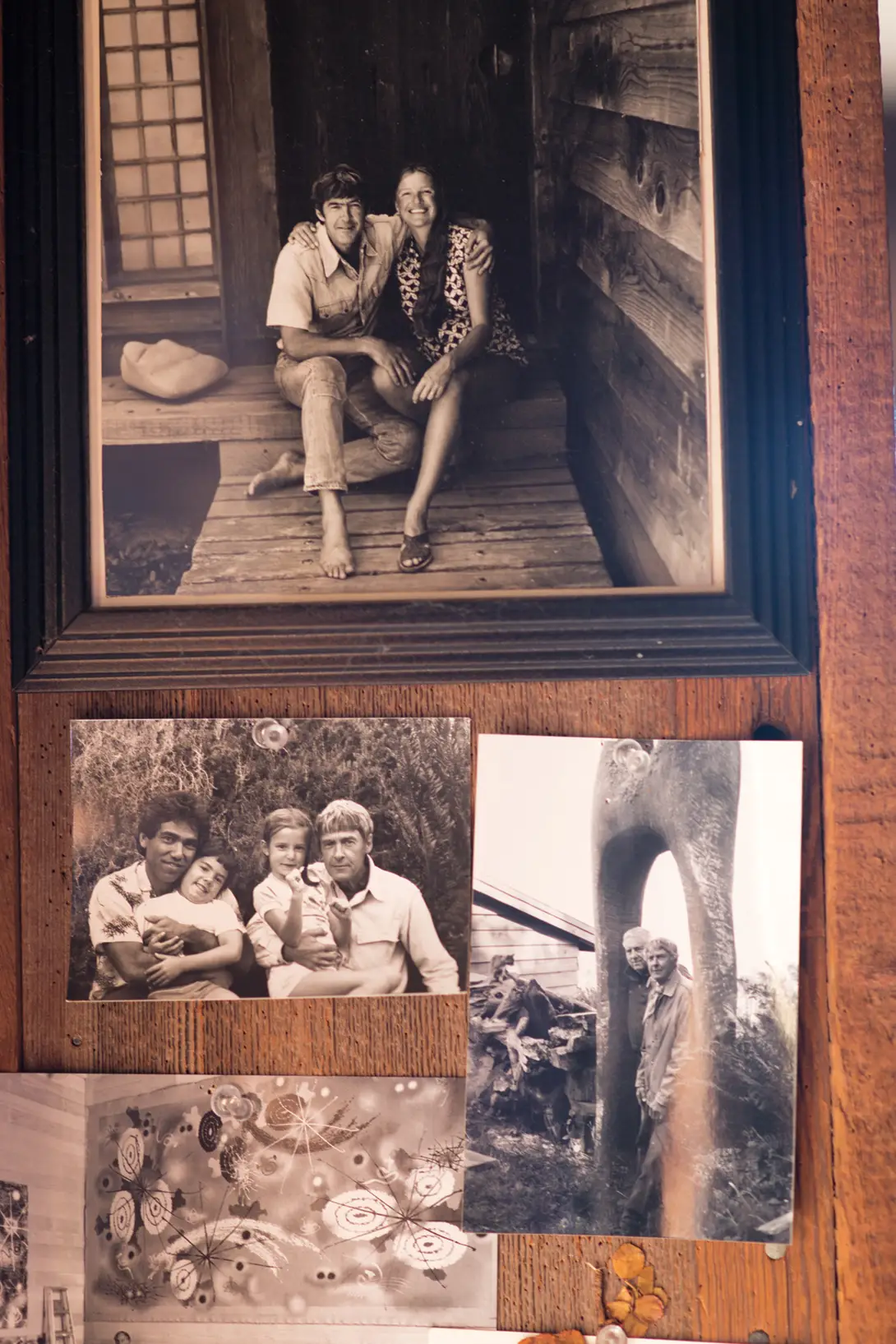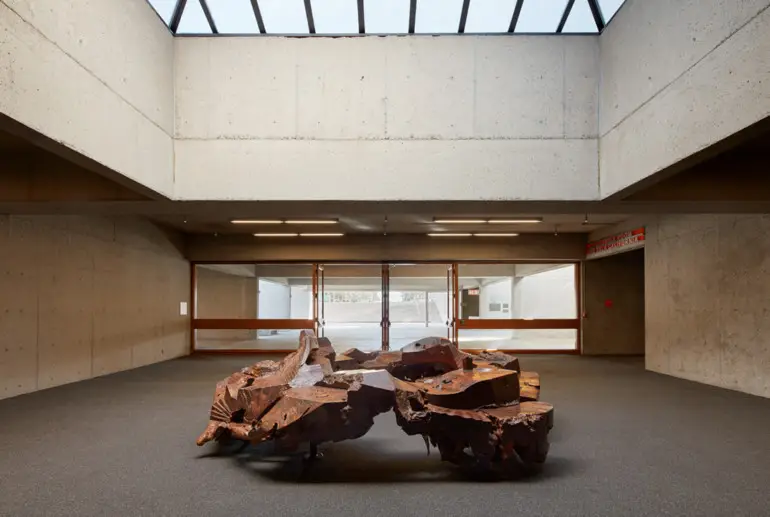At the Oakland Museum of California, an unsung designer/artist finally gets the limelight.
IT IS THE RARE HOUSE that is a complete reflection of the people living in it, but that is exactly the case with the Inverness home of artist J.B. (James Blain) Blunk, who hand-built the sculptural wood cottage he moved into with his first wife and where he raised his children from the 1960s on. It became a place to experiment with different artistic mediums until his death in 2002; there, he fashioned furniture, carved cypress wood sinks, made ceramic and bronze vessels and utensils, and even made some of his clothing by hand from deer hides. A Brancusi-esque archway at the entrance to the property is carved from solid salvaged redwood. Several other large site-specific sculptural works also by Blunk are scattered all over the Bay Area in places such as Greens restaurant in San Francisco, but the house, which used to host an arts residency managed by his daughter Mariah Nielson in collaboration with the Lucid Art Foundation, remains Blunk’s most complete and instructive legacy for anyone with a holistic back-to-nature bent. Blunk, who studied ceramics at UCLA and worked with master potters in Japan thanks to a chance encounter and friendship with the sculptor Isamu Noguchi, subsequently made a living for a time by building houses. The first of those, in 1957, was for abstract expressionist painter artist Gordon Onslow Ford in rural Inverness. A year later, Blunk’s own house was begun in Inverness on an acre of land given to him by Ford, who became his lifelong patron.
Blunk, who studied ceramics at UCLA and worked with master potters in Japan thanks to a chance encounter and friendship with the sculptor Isamu Noguchi, subsequently made a living for a time by building houses. The first of those, in 1957, was for abstract expressionist painter artist Gordon Onslow Ford in rural Inverness. A year later, Blunk’s own house was begun in Inverness on an acre of land given to him by Ford, who became his lifelong patron.


Inspired by Japanese Zen philosophy and influenced by green-thinking utopian hippie communities, “Blunk made a seamless connection between art and nature, using materials from the landscapes around him to create objects he and his family used every day,” says Oakland Museum of California curator Carin Adams.
Painstakingly delving into Blunk’s rich visual treasury with Nielson’s cooperation, Adams is forming a retrospective called J.B. Blunk: Nature, Art & Everyday Life, that will be featured at the museum from April 21 to September 9; it will offer insights on this Northern California Renaissance man who made nature-inspired utilitarian objects as a way of shaping an artful life.
 The exhibition aims to showcase how Blunk drew inspiration from nature to create usable artworks that included ceramics and sculpture. Blunk used materials such as hollowed-out redwood burls for furniture, a variety of local clays for pottery and local stones for jewelry.
The exhibition aims to showcase how Blunk drew inspiration from nature to create usable artworks that included ceramics and sculpture. Blunk used materials such as hollowed-out redwood burls for furniture, a variety of local clays for pottery and local stones for jewelry.

Such designs became ubiquitous in the Bay Area and part of the region’s aesthetic, even though people were rarely aware of where it started.
“J.B. Blunk shaped much of postwar art and design in Northern California, yet had very little exposure,” Adams says. This exhibition will, for the first time, display a wide range of his objects, photographs of site-specific works and essays about his work and include interviews with people who knew the artist well.
 “We won’t be trying to re-create his home,” Adams says, but by telling the story of the house and highlighting certain works from it, the exhibition will demonstrate “how he learned as he made, and the way that he was able to scale his ideas and apply them to a broad range of materials.”
“We won’t be trying to re-create his home,” Adams says, but by telling the story of the house and highlighting certain works from it, the exhibition will demonstrate “how he learned as he made, and the way that he was able to scale his ideas and apply them to a broad range of materials.”
Although he was not widely known, Blunk’s impact — via the house — continues to widen. Joshua Tree sculptor Alma Allen, who is two decades younger than Blunk and has never met him, was clearly influenced by the older artist’s work; his pieces will be showcased alongside Blunk’s at the Palm Springs Art Museum later this year. Since 2009, emerging international artists such as Max Lamb, Gemma Holt, Jacob Tillman, Jay Nelson, Rachel Kaye, Rainer Spehl and Harry Thaler have been invited to live and work at Blunk’s house, channeling the artist’s ethos at the source.
 “The Planet,” a huge redwood burl sculpture commissioned by the Oakland Museum in 1968 and installed there in 1969 just weeks before the building was completed, is another influential piece and one that illuminates the artist’s process. Like a modern-day Michelangelo, Blunk let the material reveal what it could be shaped into and, working with chisels and chainsaws, “he carved out voids for seating within the natural form. ‘The Planet’ is both a design object and art,” Adams says. It is also an interactive piece that children can clamber into and are encouraged to play with.
“The Planet,” a huge redwood burl sculpture commissioned by the Oakland Museum in 1968 and installed there in 1969 just weeks before the building was completed, is another influential piece and one that illuminates the artist’s process. Like a modern-day Michelangelo, Blunk let the material reveal what it could be shaped into and, working with chisels and chainsaws, “he carved out voids for seating within the natural form. ‘The Planet’ is both a design object and art,” Adams says. It is also an interactive piece that children can clamber into and are encouraged to play with.
 “It helped Blunk develop his style,” Adams says. “Later large-scale seating sculptures he created were all meant to be touched, sat on and engaged with.”
“It helped Blunk develop his style,” Adams says. “Later large-scale seating sculptures he created were all meant to be touched, sat on and engaged with.”
Placed in the foyer of the museum, “The Planet” signals the museum’s interest in local materials and crafts, and “many generations of museum goers have come here to sit on it, run their hands along it, and it is an important part of Oakland, really,” Adams says. “It is not just an object; it is a seating sculpture and an experience that blurs the line between the natural and the crafted.”


